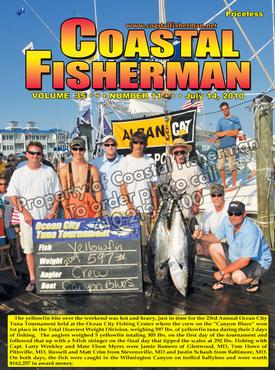


Article by Pat Schrawder
 WEATHER SERVICES
WEATHER SERVICES
Continuing our discussion from last week’s article about weather reception, let’s talk about satellite radio. Arguably one of the most important concerns for boaters is weather conditions for safety purposes, but fishermen have found that a number of weather factors such as sea surface temperature also make a huge difference.
There are a number of ways to get weather information. Your VHF and/or SSB radio both have weather stations that broadcast weather forecasts on a continuous basis. Their information covers a general broad area and is confined to wave heights, wind speed, direction and storm updates.
Last week I talked about the weather module station that Furuno uses which gives you a great deal of information in real time but has no predictive features.
For that, the latest entry into the field is the Satellite Weather Receiver. The weather information you can receive is detailed. Here are just a few possible items: animated weather radar, lightning strikes, tropical storm tracks, high resolution sea surface temperature with warmer water shown in different color, storm cell tracks, watches and warnings, marine zone forecasts and warnings, marine observations and buoy reports, surface features, squall lines and pressure, forecast wave height, period and direction, forecast winds, NOAA marine zone forecasts, marine watch box, echo tops, and city forecasts. Actual display and manipulation of data may vary depending on which model of marine plotter or PC software you have but they all have the same basic information since they are all receiving it from the same source,
Currently, there are two main providers of this service owned by the same parent company, Sirius XM Radio, Inc. The two companies completed their merger (technically the acquisition of XM by Sirius) on July 29, 2008. XM and Sirius use different compression and conditional access systems, currently making their receivers incompatible with each other's service, though both companies have guaranteed that existing receivers will be able to receive content from both services in time. As more and more people sign on to satellite radio, the addition of the hardware for satellite weather is becoming very popular and, once the equipment is purchased and installed, the additional service fee is very minor.
The two companies are very competitive and are sold and advertised under two different labels even though the parent company is the same. The important thing for the buyer to consider is the chartplotter that is being used, since some of them use one type and the other may not. For example, Garmin uses XM but Furuno and Northstar use Sirius. We remain hopeful that, at some point, the merger will be fully complete and the software will be compatible with all units.
Installation of these units is really quite simple. Installation involves hook up of a Sirius or XM weather receiver to your 12 volt supply, mounting an antenna and running the cable from it to the receiver, connecting it to your chart plotter or PC, then subscribing to the service.
If you want to add simultaneous reception of satellite radio to your package, you must have a satellite receiver, tuner and speakers or, if you already have a stereo on your boat, just a satellite receiver. Both companies offer a special rate to add radio service if you don’t already have it. Because it is Satellite based, weather reception is available within any of the 48 contiguous states and hundreds of miles into the Atlantic and Pacific Oceans as well as the Caribbean Sea and the Gulf of Mexico.
Pat and her husband, Larry are owners of L&L Marine Electronics in West Ocean City, MD.